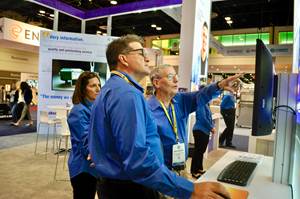Can Lasers Make the Cut For Trimming Complex Parts?
In Europe and the Asia-Pacific region, laser trimming is reportedly making in-line thermoforming and trimming of heavy-gauge industrial parts more viable and cost-effective than in the past.
In Europe and the Asia-Pacific region, laser trimming is reportedly making in-line thermoforming and trimming of heavy-gauge industrial parts more viable and cost-effective than in the past. In the U.S., industry sources are more skeptical about its cost-effectiveness.
A major proponent of laser trimming is Comi Cannon Technology (CCT) in Italy. CCT is a joint venture of two other Italian firms, Comi Srl and the Cannon Group. CCT's approach is to integrate the thermoforming and finishing steps in a continuous operation using Comi's high-speed laser trimmers. CCT's laser-trimming equipment has made early inroads in refrigerator-liner manufacturing in Europe, Australia, and China. Comi Cannon attributes this to the need for extensive cut, trim, and punch operations in refrigerator liners and to the need for quick changeovers imposed by frequent styling changes in regional refrigerator markets.
"Laser trimming also has potential beyond liners," says Giancarlo Fumagalli, a CCT marketing official, who cites the automotive, appliance, and toy sectors. CCT argues that in-line laser trimming offers significant opportunities for improving part quality, reducing part cost, and boosting overall thermoforming productivity.
Nevertheless, industry sources in the U.S. generally remain convinced that five-axis CNC routing is still the most efficient trimming method for most industrial parts. Lack of familiarity with lasers by U.S. processors is one factor, says William Kent, v.p. of thermoforming at Brown Machine in Beaverton, Mich. Also, laser equipment can be five times more costly than CNC routers. CCT responds that laser systems offer long-term cost advantages.
"The big advantages of laser trimming are the high-quality cut and systems-wide cost savings," states Fumagalli. In laser trimming, plastic is vaporized along a cutting path that is very accurate and precise. Width of the cut is 0.2 mm versus 3 mm for CNC routers. That can translate into material savings, lower reject rates, and less need for post-finishing. Lasers can cut complex profiles—the minimal turning radius is 0.25 mm. Lasers also do not produce dust (swarf), which can interfere with vacuum forming and other dust-sensitive operations.
Another source of savings is a dramatic reduction in trim tooling costs. Laser trimming involves no contact between the laser head and part surfaces, so simple, lower-cost fixtures can be used to lock parts in place. CNC cutting programs for lasers can be changed in 5 minutes, which CCT claims is far quicker than for CNC routers.
Rethinking in-line trim
"Every heavy-gauge thermoformer dreams of equalizing the rates of forming and part trimming," comments James Throne, president of consulting firm Sherwood Technologies. He says forming rates generally exceed trimming by a factor of about two. Throne says a rough parity between those diverging rates is crucial to reaping the benefits of in-line forming-and-trimming.
CCT views 3D CNC laser-cutting systems as a promising way to achieve form-and-trim parity since the laser systems are fast and can be customized to balance forming and trimming throughputs. Trimming speed depends on many factors, including the material, part thickness, and complexity of the trim profile. However, laser trimming can match five-axis CNC routing in some cases, CCT claims, adding that the availability of laser-cutting equipment in both one- and two-table versions makes it easy to match thermoforming and trimming rates.
For example, CCT offers the Esacut Evolution laser system with two working tables. It's aimed primarily at refrigerator liners. Laser-head and table movements are synchronized during trimming. Esacut systems have been sold to Electrolux companies in Spain, Sweden, and Australia. In two cases, twin formers feed liners to separate tables on a single Esacut laser trim system.
CCT recently brought out the Simo laser system, with a single work table that remains stationary during trimming. Fumagalli says this is a promising approach to trimming automotive parts, appliances, toys, and even sunglasses. U.S. sources agree that auto-interior parts are a promising niche for laser trimming. They note that lasers provide a high-quality edge without the need for additional finishing steps.
Throne comments that different plastics respond differently to vaporization by the laser beam: Some materials, like acrylic, accept it easily while others tend to burn. Reinforced resins, foams, and laminates incorporating textiles or other combustibles are not good candidates for this method, Throne suggests. CCT says virtually all thermoplastics can be laser trimmed, although it does not recommend it for PVC and glass-reinforced materials.
There is widespread concern in the U.S. that laser trimming creates fumes and odors in the workplace. CCT offers special fume-removal equipment as an option for its systems, though it adds to cost.
Related Content
Collaboration Key to Development of Thermoformed EV Charging Stations
Heavy-gauge former Ray Products and custom sheet extruder Sekisui Kydex combine expertise in materials science and processing to commercialize cost-effective charging units.
Read MoreInteractive Training for Injection, Extrusion and Other Processes
Paulson has four in-booth stations demonstrating its various training solutions.
Read MoreWinners Announced for SPE Thermoforming 2023 Parts Competition
More than 30 entries were considered, including 10 in the Sustainability category.
Read MoreSheet Extrusion, Thermoforming Tips for PLA/aPHA Blends
Biopolymers like PLA and PHA are able to meet sustainability goals while also delivering the performance attributes needed in rigid food packaging. Here’s what testing has shown.
Read MoreRead Next
See Recyclers Close the Loop on Trade Show Production Scrap at NPE2024
A collaboration between show organizer PLASTICS, recycler CPR and size reduction experts WEIMA and Conair recovered and recycled all production scrap at NPE2024.
Read MoreMaking the Circular Economy a Reality
Driven by brand owner demands and new worldwide legislation, the entire supply chain is working toward the shift to circularity, with some evidence the circular economy has already begun.
Read More









